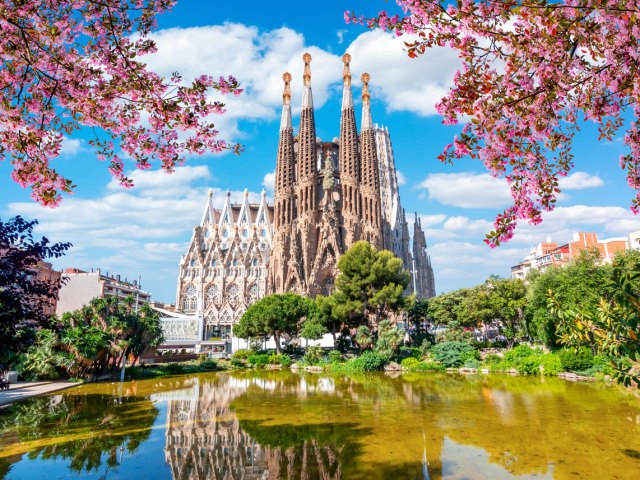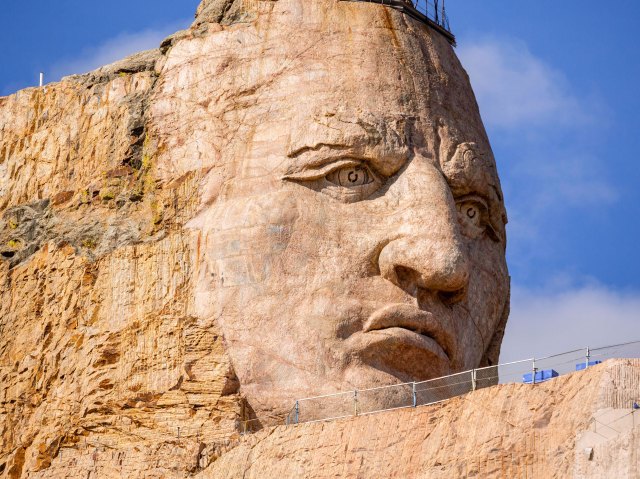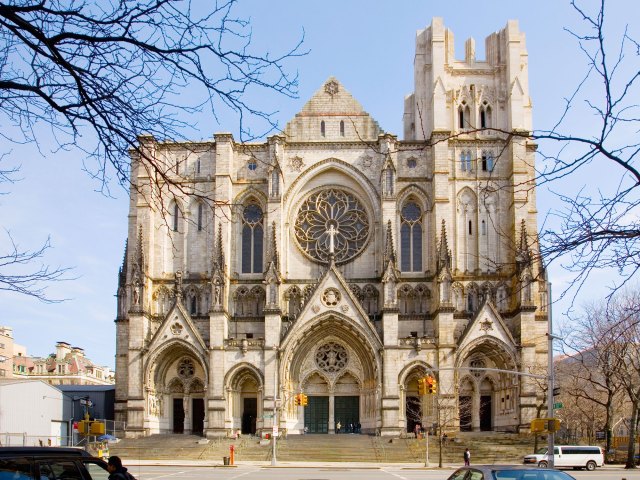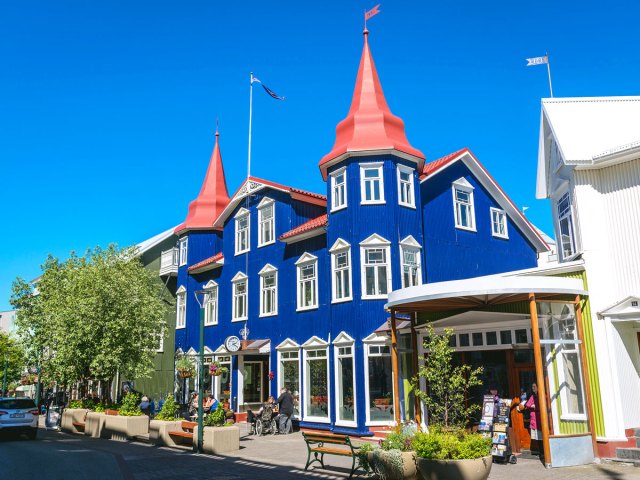Some famous landmarks are still evolving. From a memorial slowly emerging from the Black Hills of South Dakota to a cathedral under construction for more than 125 years, unfinished buildings and monuments hold a particular fascination — inviting visitors to envision them as they someday could be. Discover the fascinating reasons these six incredible landmarks around the world remain under construction.
La Sagrada Família – Barcelona, Spain

Antoni Gaudí, the visionary architect behind many of Barcelona’s most celebrated buildings, was hired to take over the construction of the city’s Roman Catholic basilica in 1883 when he was only 31 years old. From that time until his sudden death in 1926, Gaudí lovingly labored on the building, his masterwork. The cathedral’s exterior features a magical collection of drip-castle spires; on the inside, intense beams of sunlight filter through stained glass to illuminate a forest of columns.
Gaudí was legendarily whimsical — sometimes changing a design simply because he’d become enamored of a particular stone from a quarry. Gaudí made sketches and plaster models of his vision — some were even large enough to walk through. These had to suffice for the engineers and architects who took over the project when he died with only less than a quarter of the construction completed and no explicit plans. A current architect on the project, Jordi Faulí, told “Time” magazine, “Gaudí left us the path. Sometimes, though, we’ve had to work hard to find it.”
Over 4 million visitors come to La Sagrada Familia each year. The nave was finished and consecrated by the pope in 2010. Hundreds of workers arrive daily to the site to put the finishing touches on the church, which is expected to be completed in 2026 — just in time for the centenary of Gaudí’s death. However, after a century of delays from war, economic hardship, and pushback from the diocese and the local residents, that date may be pushed back yet again.
Hassan Tower – Rabat, Morocco

Construction on this magnificent unfinished tower began in 1195 during a period of optimism and expansion of the Islamic world. At the time, Rabat, Morocco, was a small town, but was expected to grow into a cultural and political stronghold due to its location between Marrakech and Cordoba, the capital of western Islam at that time. The tower, at 144 feet (just half of its intended height), was to be the minaret of a grand mosque from which the faithful were called to prayer. Progress on the mosque and minaret ceased when the sultan-architect, Yacoub el-Mansour, died in 1199. Much of the unfinished construction site was destroyed by a massive earthquake in 1755, leaving only the Hassan tower and the vast marble floor and 200 supporting columns that show the massive footprint once planned for the unfinished mosque.
The tower’s design honors the ingenious architects of the period. Instead of stairs, a series of ramps wind to the top of the tower. This allowed animals to haul stones up during construction. The intricate decorative inscriptions and patterns on the exterior mirror other architectural wonders by el-Mansour such as the Giralda, the belltower of the Seville cathedral (which, of course, was converted from a minaret when Christians drove the Muslims from Spain). Together, Rabat and the Hassan Tower are a designated UNESCO World Heritage Site.
Winchester Mystery House – San Jose, California

Anyone who has seen a Western film might be familiar with the name Winchester. The Winchester Repeating Arms Company made firearms including a rifle that became known as “the gun that won the West.” When the heir to the sizable Winchester fortune died in 1881, his widow Sarah Winchester used part of her $20 million inheritance to begin renovations on an eight-room house she bought in San Jose, California. The problem was that she never stopped the expansion.
According to some theories, the ghosts of victims who died from Winchester gun violence haunted the house and drove Sarah to continue building new rooms, hoping that they wouldn’t inhabit them. Another theory is that a medium told her that the only way to put off her own death was to continuously add on to the house. Or perhaps she simply was eccentric.
Whatever the reason for the must-build mania, construction on the house continued around the clock from 1884 until Sarah’s death in 1922. The Queen Anne-style Victorian mansion, which is listed on the National Register of Historic Places, has 160 rooms, 2,000 doors, 17 chimneys, and numerous staircases that lead to nowhere.
Crazy Horse Memorial – Black Hills, South Dakota

Roughly a million visitors a year make the journey to the unfinished Crazy Horse memorial in the Black Hills of South Dakota. Crazy Horse was the Oglala Lakota chief who successfully fought Custer’s army at the 1876 Battle of Little Big Horn. The majestic profile of Crazy Horse, carved into a rocky mountain face, is the first finished segment of a project intended to produce the largest sculpture in the world.
When completed, the memorial will depict the tribal leader on horseback with his left arm pointing southeast. The planned monument will be so epic in scale that it will be four times the height of the Statue of Liberty and will dwarf the presidents carved into Mount Rushmore — located just 17 miles away. In fact, if those politician heads were stacked one on top the other, they would only reach half the height of Crazy Horse.
Progress on the project, which began in 1948 as a response to Mount Rushmore’s depiction of white leaders in a region that was historically populated by Native Americans, has been slow. The work’s Polish-American sculptor, Korczak Ziolkowski, worked alone on the project for many years, but was eventually joined by volunteers and family and received funding through private donations and admission fees paid by visitors. To maintain control, Ziolkowski refused federal monetary assistance.
Though the monument was initially approved by some Lakota, it has since been met with criticism from the natives about how the money was being spent, why the Ziolkowski family’s involvement often eclipses the memory of Crazy Horse in the press materials published by the memorial foundation, and why the construction project was taking so long. More than 70 years after it began, many are skeptical that the Crazy Horse memorial will ever be completed.
National Monument – Edinburgh, Scotland

When construction began in 1822 on this monument dedicated to the Scottish soldiers and sailors who died fighting in the Napoleonic Wars, fundraising still wasn’t complete. Confident that the money would come, the foundation stones were laid (the first ceremoniously put in place by King George IV) and the columns began rising atop Carlton Hill in Edinburgh. Then, the money dried up.
The design was intended to exactly replicate that of the Acropolis with the stones quarried in Scotland, but in 1829, construction stopped after only 12 columns had been erected and topped by their lintels. Discussions about how to use the unfinished hilltop memorial have come up in the ensuing years including the possibility of it being used as a site for museums or government buildings. So far, the monument stands incomplete. Although it’s unfinished, the hilltop monument is still a popular site for picnics and Sunday walks.
Cathedral of St. John the Divine – New York, New York

St. John the Divine, one of the world’s largest Gothic-style cathedrals, remarkably remains unfinished despite 120 years of construction. The magnificent church is a landmark in the hilly Morningside Heights neighborhood of New York City between Central Park and Columbia University.
Construction on the grand building began in 1892, but even after delays and changes in design and architectural leadership, the first services were held in the unfinished (but habitable) church in 1911. As time went on, the Episcopal church’s leaders decided to prioritize funding for community needs over ongoing construction.
Since 1978, the cathedral has trained young people from the local community as apprentices to the stonecutters who work on the structure. The building, although only two-thirds completed, has been the site of major historic moments such as concerts of new works by Duke Ellington and Leonard Bernstein, highwire walking by Philippe Petit, and numerous anti-war demonstrations.
More from our network
Daily Passport is part of Optimism, which publishes content that uplifts, informs, and inspires.























